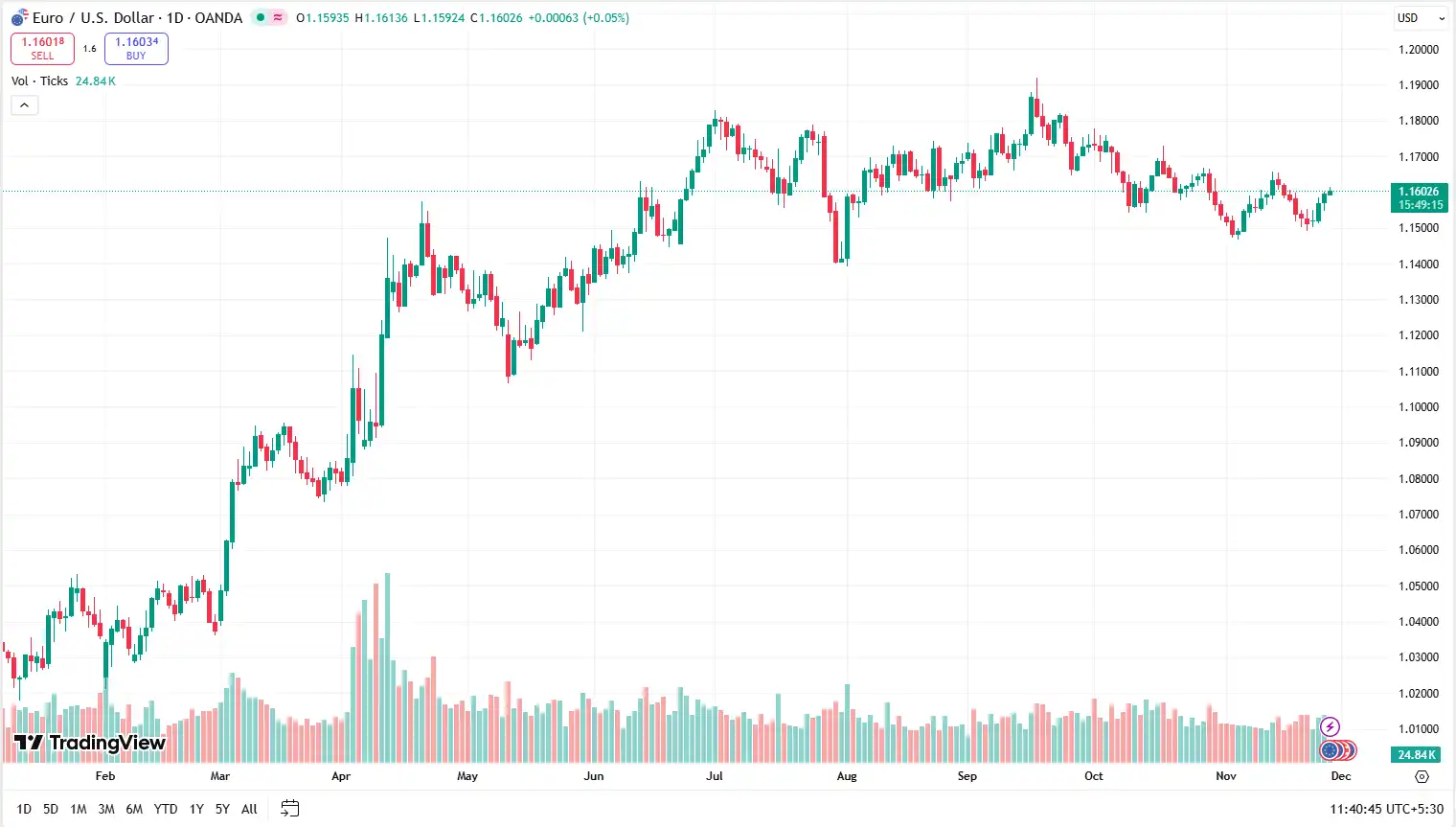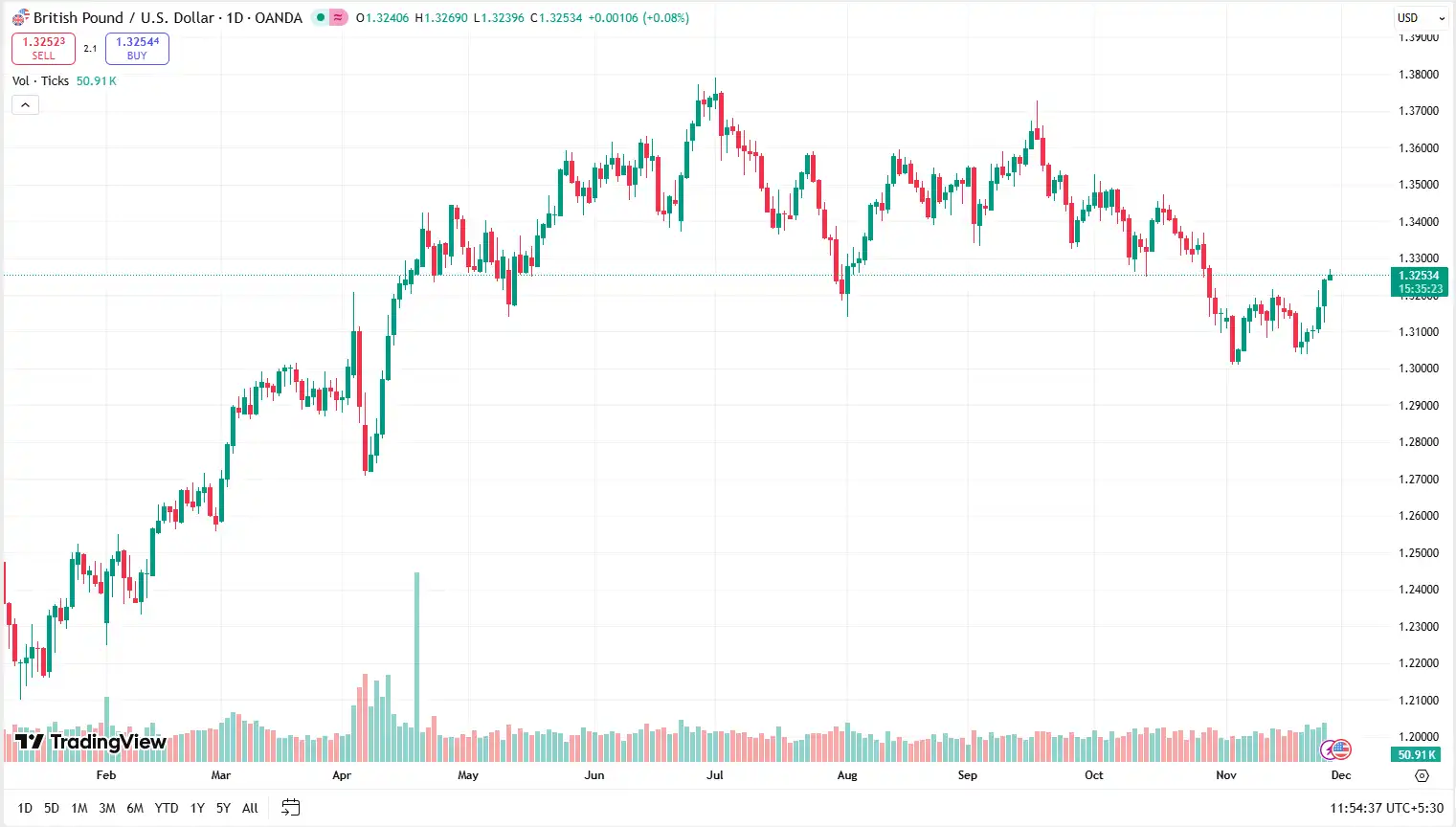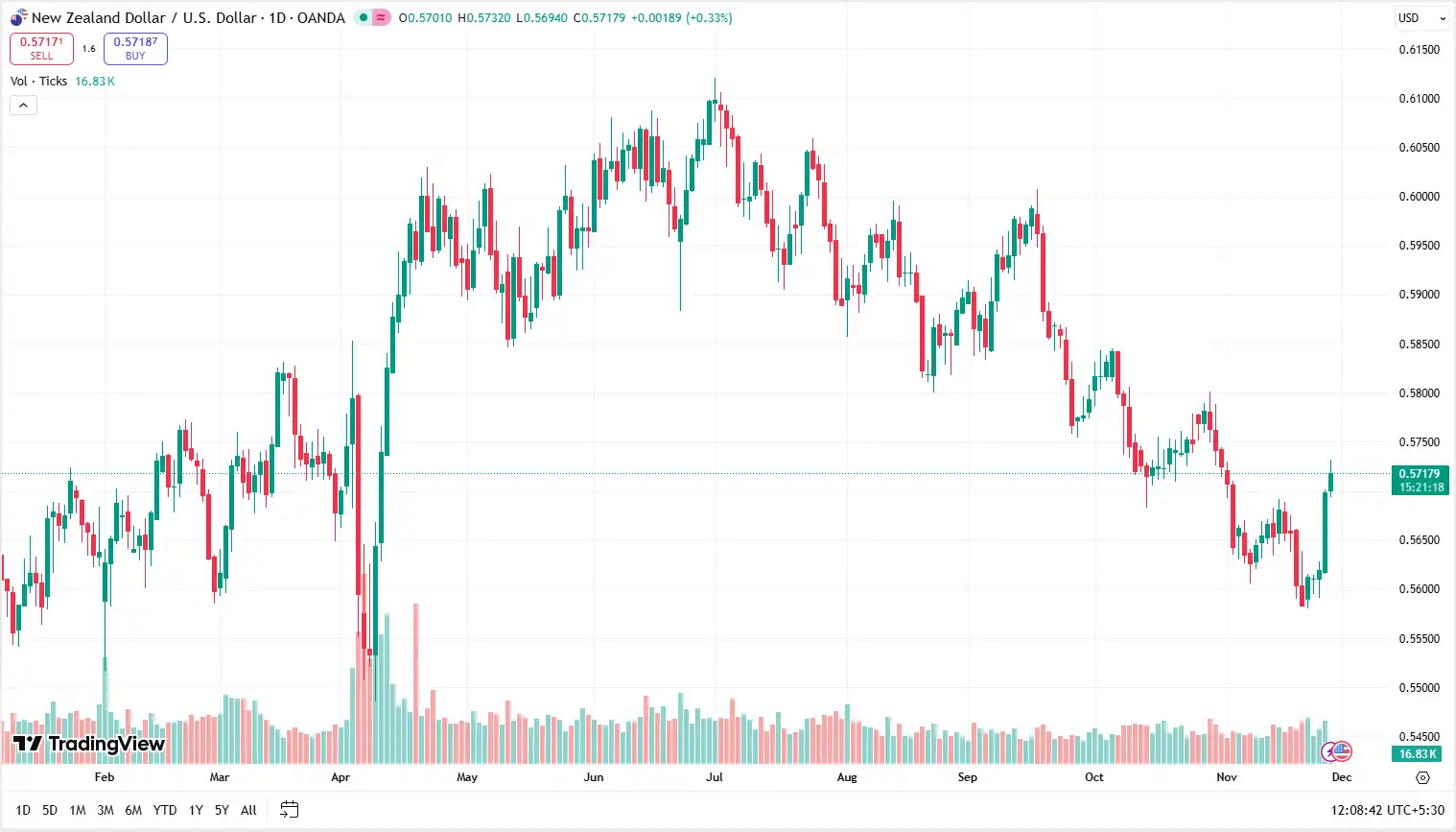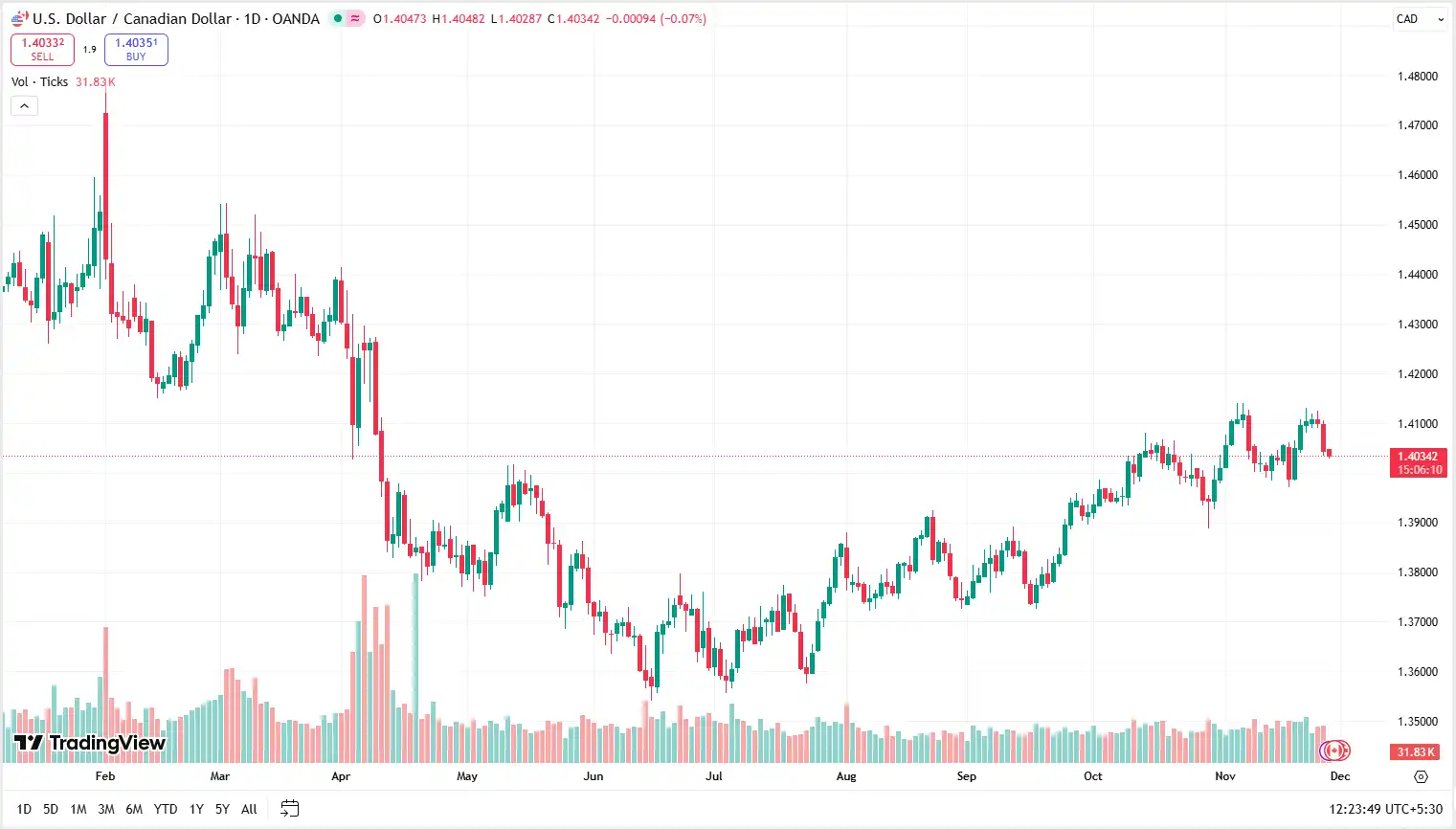The EUR/USD pair traded comfortably above 1.1600[1], extending its advance for a fourth consecutive session, in early Thursday session and approaching a one-and-a-half-week high. The move is believed to have kept the two in sight of the 200-day Simple Moving Average (SMA), which is one of the essential technical barriers that have, so far, restricted the further increases. The market participants are still keen to understand the ability of the two to make a lasting break above this point especially in light of the lesser liquidity conditions linked with the US Thanksgiving holiday[2].
Market reports point out that the US dollar is on the defensive front, burdened by dovish Federal Reserve (Fed)[3] expectations and another slumping USD Index (DXY) to a one-week low. Traders have now placed a high likelihood of another US rate cut in December after the latest remarks of the Fed officials[4], which strengthened the perception that interest rates on borrowing can be lowered again before the year ends. A mixed set of economic data in the US with signs of sluggish activity and muted demand has not given the dollar much reason to go up and thus a short-term boost to the EUR/USD exchange rate.
Market commentators[5] point out that the European Central Bank (ECB) is cautious but constant in its policy position, which makes the euro a gain on the European side. According to recent comments by ECB officials, notably Vice President Luis de Guindos and Chief Economist Philip Lane[6], the present level of setting the rate is also correct and only after inflation becomes significantly lower than target may consideration of further policy easing be done. This relatively steady view has contributed to a positive tone surrounding the single currency in the short-term.
Analysts[7] suggest that, in the future, investors will be closely tracking future US releases such as weekly jobless claims, consumer sentiment surveys to give further indication on the underlying economic momentum. Any further indications of the declining demand or labour-market weakness may continue to put pressure on the dollar, consequently benefiting the pair. Nevertheless, the medium-term perspective is more equalized where the global growth risks and Eurozone-specific[8] uncertainties curtail the chances of uncontrolled bullish run.

GBP/USD Extends Gains as Dollar Softens
GBP/USD traded near 1.3260[9], extending its advance for a sixth consecutive session in Thursday's Asian hours as the pair continued to benefit from sustained US dollar softness. The price action[10] is believed to have indicated a positive near-term tone with buyers controlling the price though there were intraday consolidations. The pound has gained strength on its path following overall US dollar weakness that has been attributed to changing Fed expectations[11] that have seen the pair maintaining at comfortably above recent breakout levels.
Market reports[12] indicate that the US dollar is not out of the woods even after better-than-anticipated US data, which saw a decline in the Initial Jobless Claims to 216,000 and more robust Durable Goods Orders. Markets have been peering beyond the data, focusing instead on the growing expectations of a 25-point-cut at the Fed meeting in December. The CME FedWatch Tool currently indicates an over 84% likelihood to soothe compared to approximately 30% a week prior. Rumours of a strong candidate like Kevin Hassett[13] who is considered a supporter of low rates as Fed chair have strengthened the pressure of downside on the US yields and consequently the dollar.
Market commentators[14] note that this time around the pound has been given a reprieve in the Budget, with Chancellor Rachel Reeves announcing a rise in tax amounting to 26 billion and demonstrating that the country has a fiscal headroom of 22 billion. Though the actions indicate a desire to maintain fiscal discipline, the assessment of the Office for Budget Responsibility that this leeway is limited dampens the long-term perspective. At least in the short term, however, the fiscally conservative approach has served to stabilise the mood towards the pound[15].
Analysts[16] suggest that in the future, the focus will shift to future US economic announcements, especially the inflation and consumer-spending statistics, which can impact the prospects of rate cuts. Any indication of a declining economic momentum would leave the US dollar[17] on the defensive and provide additional short-term support to the duo, but longer-term risks are skewed towards a more pessimistic view of the pound. With the dollar still pressured by dovish Fed expectations, the GBP/USD exchange rate remains supported in the near term despite longer-term fiscal and growth risks.

NZD/USD Advances on Softer Dollar and Upbeat Data
The NZD/USD traded around 0.5710[18] pair, extending its recent advance in early Thursday's Asian session as the New Zealand dollar benefits from a combination of stronger domestic data and a softer US dollar. The price movement[19] is believed to be constructive in the short run as the two are continuing to trade above its short-term support area at around 0.5670 and displaying some indications of positive momentum. The proximate stimulus to the move has been the current renewed weakness of the US dollar[20] as markets once again consider the possibility of further Fed rate cut in December.
Market reports[21] indicate that the Q3 Retail Sales report by New Zealand gave the market an extra boost with headline and core sales increasing 1.9% QoQ and by far outpacing the expectations. The figures, coupled with the ANZ Business Outlook[22] survey which indicated business confidence at an 11-year-high, boosted the positive domestic growth story and supported demand for the kiwi. As these releases do not materially change expectations of the policy path of the Reserve Bank of New Zealand (RBNZ)[23], they assist in the short-term resilience of the New Zealand dollar.
Market commentators[24] observe that the greenback is also under pressure in the US due to political events, as it is being reported that President Donald Trump might consider a successor to Fed Chair Jerome Powell in the person of Kevin Hassett. The perception of the market that Hassett might be more dovish, has put pressure on the dollar, but this effect is slightly mitigated by stronger labour market signals. First Time Jobless Claims had dropped to 216,000, the lowest since April, which gives some encouragement to the US dollar mood.
Analysts[25] state that in the future, the focus shifts to the future US economic data, such as PCE inflation and ISM data, which can give the pair a new direction. Weak figures would probably support anticipations of more policy easing and maintain the US dollar[26] on defense, continuing to push the two upwards. Nevertheless, the medium-term risks are still skewed towards uncertainty of growth in the world which can curtail returns. Overall, the NZD/USD exchange rate remains supported in the near term as softer US dollar trends and robust New Zealand data continue to underpin kiwi demand.

USD/CAD Weakens as Dollar Sentiment Softens
The USD/CAD pair stayed steady, trading near 1.4030[27] in Thursday's early session, consolidating Wednesday’s decline as the US dollar remains under broad pressure. The most recent pullback of the pair is believed to have indicated a reiteration of the US dollar[28] weakness and traders were getting more and more position toward further Fed cuts at the end of the year. With the US markets closed[29] on Thanksgiving, intraday flows should be low, keeping the pair in a tight trading band but the sentiment surrounding monetary policy in the US and directing the markets.
Market reports[30] indicate that the US Dollar Index (DXY) has fallen to approximately 99.45, the lowest point in more than a week, following a sharp reversal in the rate-cut expectations of the last month. CME FedWatch tool has now put an 84.7% likelihood on a December reduction, increased by merely 30% a week earlier, after dovish remarks by New York Fed President John Williams[31]. His focus on downside risks in the labour-market has strengthened the anticipation that Fed would switch to an easier policy in the near future rather than in the distant past. This US dollar loftiness also speaks against the immediate prospects of the pound, with the poor US numbers and declining yields dragging the greenback in most of the major pairs.
Analysts[32] suggest that in the short-run, the lighter trading environment and the shallow liquidity levels can constrain volatility, yet the focus will shift to the release of the US ISM Manufacturing PMI on Monday, which is one of the most important indicators of economic momentum. More indicators of declining action would probably enhance the argument in favour of more policy relaxation, exposing the US dollar[33] and providing slight relief to downside ones, and also dampening GBP upside action against the US dollar.
Market commentators[34] look forward to the refocusing on the release of Q3 GDP on Friday, where the consensus is that the annualised growth will revert to 0.5 per cent after a contraction in the previous quarter. The Canadian dollar could be supported by a firmer print in the short term, but threats in the medium-term remain as domestic demand is slowing and risks of the Bank of Canada (BoC)[35] having a reserved policy stance. The USD/CAD exchange rate is likely to remain range-bound near term as soft US data and dovish Fed expectations keep the dollar under pressure amid thin holiday liquidity.

Stay Ahead in the Currency Game
Whether you're a daily FX trader or handle international transactions regularly, our 'Currency Pulse' newsletter delivers the news you need to make more informed decisions. Receive concise updates and in-depth insights directly in your LinkedIn feed.
Subscribe to 'Currency Pulse' now and never miss a beat in the currency markets!
Ready to act on today’s insights? Get a free quote or give us a call on: +44 (0)20 7740 0000 to connect with a dedicated portfolio manager for tailored support.
Important Disclaimer: This blog is for informational purposes only and should not be considered financial advice. Currency Solutions does not take into account the investment objectives, financial situation, or specific needs of any individual readers. We do not endorse or recommend any specific financial strategies, products, or services mentioned in this content. All information is provided “as is” without any representations or warranties, express or implied, regarding its accuracy, completeness, or timeliness.




